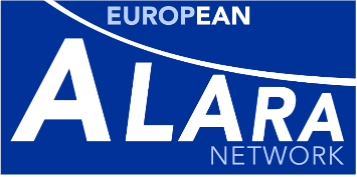Newsletter 28
C. Lefaure
In France there are currently more than 20,000 “Personnes Compétentes en Radioprotection” (PCR)/Radiation Protection Officers (RPO) and other radiation protection partners, such as occupational physicians involved in radiation protection. In the medical, research and non nuclear industry sectors, they can often feel isolated, not given appropriate recognition either within their organisations or by their colleagues, and sometimes struggle to keep up to date in regard to the continuing changes in regulations which have evolved significantly in recent years.
In order to address some of these concerns, a number of networks have recently been established at regional levels to provide a forum to share experiences and to learn from both each other and also from experts such as regulatory bodies and commercial companies. The desire to establish these networks began several years ago, but real progress was made during 2009 and 2010. At the beginning of 2011, eight networks have now been set up, covering approximately half of the 22 regions in France. One thousand individuals now participate in these networks, which continue to increase both in size and in the range of activities carried out. Typical activities include the holding of seminars and the creation of working groups, the establishment of web forums, sector specific training initiatives and the publication of newsletters. Seven of the networks are open to participants from all sectors (medical, research, industry) while the eight one is dedicated solely to participants in the medical sector.
In establishing these networks, the participants now feel that there is at last a forum in which their concerns can be addressed and their status among their colleagues, and within their organisations, is now better recognised. In recognition of the importance of participation at seminars, one of the networks now provides an official “continuing training certificate” to all attendees. It is interesting to note that this network is the only one to regularly receive participants from the industrial sector. Three of the networks also have the support of an important public institution, such as a regional hospital or a university. In addition to promoting and facilitating the exchange of information between members, the networks also play an invaluable role in providing data and feedback on topics to the IAEA and other bodies on issues such as incidents for the RELIR OTHEA system, data on doses and number of procedures in interventional cardiology services and in industrial radiography companies. This is a great benefit to the IAEA, and other organisation, which would otherwise have difficulties collecting such data.
The active participation in such networks is now recognised by the French regulatory bodies (ASN and Ministry of Labour) as being extremely important and consideration is being given to making such participation a positive criterion for the renewal of the PCR certification. Furthermore, the competent authorities have also discussed the assistance they could bring to the creation of new networks and ensuring the life of the existing ones (further information can be found on the ASN website). The next step in this initiative is for these networks to be coordinated at a national level bringing together all the pilots of the regional networks.
In light of this recognition and support, further development of the current networks and the appearance of new networks to cover all parts of France are anticipated. However, it may not be possible to include each and every one of the 20000 players currently involved in radiation protection in these networks, particularly those outside the medical sector. The existence of Web forums will help to reach some of them, but Imagination, the key to all of these networks, will have to find new ways to involving everyone in the years to come.
G. Frasch
Federal Office for Radiation Protection - BfS, Germany
In Germany, about 2,500 workers are registered within the occupational category Industrial Radiography in the German Radiation Protection Register of the Federal Office for Radiation Protection (BfS). Industrial radiographers traditionally belong to one of the critical groups among radiation exposed workers. Their average annual personal doses are approximately in line with those from specific groups in the nuclear sector, nuclear medicine or interventional radiography in the medical sector and last but not least air craft crews.
The working conditions for workers in mobile industrial radiography are often exceptional. Their dosemeter evaluations frequently show smaller doses of typically one or two millisievert every month and occasionally higher doses from single incidents which, when summed, may occasionally lead to a dose limit being exceeded. In spite of the sometimes adverse working environment in on-site industrial radiography, the radiation exposure in this sector decreased substantially from 1998 to 2009 (Figure 1). It is interesting to study the change in the dose distributions over the years and to see how the fraction of workers in the different dose intervals changed and reached dose ranges which are seemingly hard to further reduce.
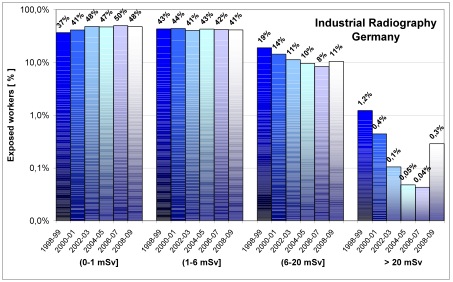
Figure 1. Change of frequency distribution of annual doses from 1998 to 2009
Cases > 20 mSv/yr: the systematic reduction in the number of workers exceeding the dose limit seems to have reached its optimum at a value below 0.5% of the measurably exposed workers. These remaining cases with overexposures seem to occur stochastically. The pattern of their monthly doses usually consists of numerous small dose values over the year, interrupted by one or two higher dose values that result in the dose limit being exceeded. The fact that there are now relatively few cases of the limits being exceeded, together with the observed characteristic pattern of monthly doses, would suggest that they cannot be avoided by applying generic ALARA measures; instead they should be addressed by specific analyses of incidents.
Cases between 6 - 20 mSv/yr: Optimisation can also be stated below the dose limit, in particular within the dose range of 6 - 20 mSv. During the course of the last decade about 10% of all measurably exposed workers remained within this dose range and it appears difficult to further reduce this value.
Cases between 1 - 6 mSv/yr: slightly more than 40% of the exposed radiographers stay relatively constant in this group.
Cases ≤ 1 mSv/yr: nowadays approximately half of all workers in this sector receive annual doses less than millisievert per year. This group necessarily increased as workers shifted from intervals with higher doses towards lower ones.
Up until 2003 there was a substantial decrease in the number of exposures that were received. In particular, the change in the intervals above 6 mSv indicates the results of a successful optimisation process. As the relative numbers remained comparably stable during the consecutive six years, it seems that optimization has lead to a level of exposure which cannot be further reduced.
By studying the changes in dose distributions it can be clearly seen the level at which systematic dose reduction has reached a level of exposure where stochastic processes (statistics) dominate. It also illustrates that a stage will occur where a generic technical and organisational measures approach to optimisation may no longer be effective and suggests that ALARA measures would be better focused on stochastically occurring single cases.
These stochastically occurring cases are probably less induced by insufficient technical protection measures; the reason lies more likely in the lack of ALARA culture, i.e. in the mind set of the workers and their management. The ALARA awareness of the workers gains importance when working on site and in absence of the direct supervision of a radiation protection officer (RPO). This ALARA awareness can be raised through briefings before and debriefings after the concrete exposure situation by the RPO. It is useful to utilize the information that is delivered from film dosemeters. Besides the individual dose, film dosemeters provide quite useful additional indicator information: together with the dose value and the exposure direction, the film can reveal specific exposure circumstances or operational mishaps that lead to exposure. Wrong handling of the film dosemeter can also be identified (Figure 2).
About 7% of all industrial radiographers are irradiated from the side and about 3% from behind. Both numbers are twice as high as the respective rates among all radiation workers and the rates remained relatively constant over the years. The analyses of the exposure direction may reveal operational mishaps or inattentiveness that lead to exposure.
Incorrect handling of the film dosemeter can also be an interesting indicator information: the rate of industrial radiographers who insert the film incorrectly into the dosemeter is seven times higher than the rate among all radiation workers. This indicates that there could be concerns regarding a group-specific lack of knowledge if not negligence in this sector rather than occasional inattention by inidvidual workers. In both cases, information about irregular dosemeter handling can be used for individual feedback in order to enhance the level of protection by raising ALARA awareness.
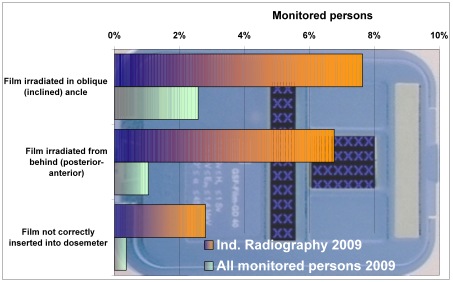
Figure 2. Mishaps or inattentiveness? What film dosemeters reveal.
The 3rd EANNORM workshop was held from 23 - 25 November 2010 in Dresden, Germany. It was organised and hosted by IAF - Radioökologie GmbH and supported by the Federal Office for Radiation Protection Germany. This workshop was dedicated to the topic Scenarios for Dose Assessments in the NORM industry". Its main goal was to familiarise the participants with different approaches developed for dose calculations in the NORM industry and to discuss the question as to whether a harmonization of these approaches should be pursued or not. Forty five experts, coming from 14 countries, took part in the discussions and shared their experiences.
Each speaker was allocated 45 minutes which included ample time for discussion. Each daily session was followed by a special round table discussion of about one hour on "burning questions". The talks reflected a wide range of situations in which the presence of NORM can cause radiation exposures to workers and/or to members of the public at a level which cannot be ignored from the radiation protection point of view. The scientific program and the single presentations of the EANNORM Round Table Workshop on Scenarios for Dose Assessments in the NORM industry" are available at the EANNORM web-page www.ean-norm.net.
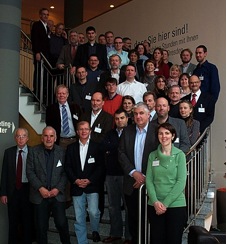
The main conclusions of the EANNORM Round Table Workshop on Scenarios for Dose Assessments in the NORM industry" were:
- We are still some way from a harmonisation of methods suited for dose assessment in the NORM industry.
- We need European guidelines for the measurements of key parameters for dose assessment and calculation of the dose for workers and, if necessary, for members of the public, too.
- The Calculation Bases for the Determination of Radiation Exposure due to Mining-caused Environmental Radioactivity (Calculation Bases Mining) published by the Federal Office for Radiation Protection (Germany) could be a basis for such a guideline.
- Measurements of the ambient gamma dose rate are one of the principal components of the monitoring programmes for workers in the NORM industry. Therefore, measurements have to be justified, since they are not applicable for a wide range of NORM.
- Radon that is released from raw materials processed in the NORM industry or from industrial residues can dominate the total exposure of persons at work. A method should be developed in order to assess the contribution of radon released from the materials of concern to the indoor concentration. The method should also be suitable to assess the release of radon from the building materials to the indoor concentration in dwellings.
- The specific activity of NORM is the basis for several assessments and therefore a key parameter in the radiation protection practice. How should it be measured efficiently and reliably, taking into account the variety of materials?
- Some of the most commonly discussed topics within the network include cross border material handling and transport of NORM in the context of different national positions. However it was agreed that the problem can only be solved in a political framework and the EC should come to a commonly accepted solution as soon as possible.
- The present state and the future of the EANNORM was the subject of a lively discussion. In particular, the participants recognised the advantages of having a well-working network with members coming from all European states as well as from abroad. The website currently gets about 1000 daily visits from members and non members of the EAN-NORM. However the fate of the network depends on the future financing.
L. Garbarino, M. Calimero
ARPAL, Environmental Protection Agency of Liguria - Italy
Description of the incident
In summer 2010 in the port of Genoa, routine radiation monitoring on incoming metallic objects detected an unexpected peak of gamma emissions coming from a container which had arrived from the United Arab Emirates. The radiation levels detected were significantly above background radiation levels. Immediately after the discovery, a Safety Plan was activated involving specialists from the Regional Environmental Agency (ARPAL) and fire fighters, with overall coordination of the plan by the Prefecture of Genoa. A precautionary no entry or exclusion zone was established at a distance of 200 m from the container; in spite of this, at the edge of the exclusion zone an environmental dose rate equivalent of 250 nSv/h could be measured, which is approximately four times higher than background levels. Measurements carried out on the container included gamma spectrometry, dose measurements and wipe testing, and the source of the radiation was identified as 60Co. Fortunately, no environmental contamination had occurred. At present, the container is still under judicial attachment.
The maximum values of environmental dose rate equivalent measured were:
- 36 mSv/h, at a distance of 0.1 m from one of the long sides of the container;
- 15 µSv/h, on the other long side of the container;
- 40 µSv/h and 75 µSv/h on the short sides of the container.
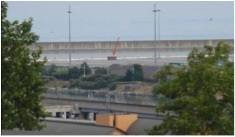
Photo 1. The container with the 60Co source on the wharf of the port of Genoa
Radiological Consequences
It is possible that workers on both ships and on the wharf may have been significantly exposed prior to the detection of the source. Hypothetical doses to these workers were estimated for a worst case scenario which assumed long exposure times, minimum distances between the container and the workers and no in-situ shielding between the source and the workers. The results of this assessment suggested that the maximum estimated effective dose to these workers would not have exceeded 1 mSv.
Lessons Learned
In order to avoid future exposure of workers to sources of ionising radiation from shipments of metallic materials, it would be advisable to:
- require sellers to provide certificates of the results of radiation monitoring of the containers;
- install radiation monitors on cranes, to provide for real time monitoring of containers during ship loading and unloading;
- provide the front line workers handing the containers with personal dosimeters.
